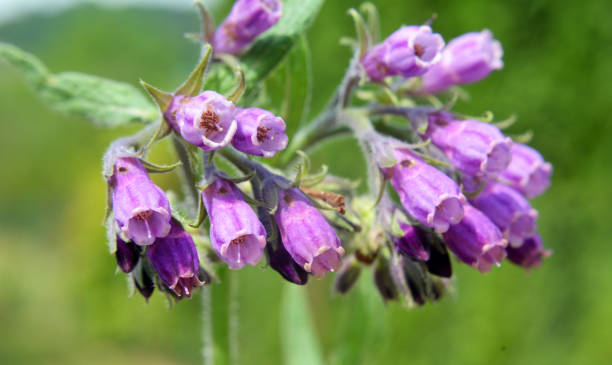Symphytum Officinale, commonly known as Comfrey or knitbone, stands as a foundational remedy in homeopathy for addressing fractures and bone injuries, particularly those affecting the bone and its periosteum—the protective outer tissue enveloping the bone. This remedy holds a unique status, rooted in its historical herbal use, where it gained recognition for its capacity to expedite the mending of fractured bones. However, modern caution has arisen due to concerns regarding potential hepatic toxicity associated with oral herbal consumption. In the realm of homeopathy, such concerns are mitigated, permitting the safe utilization of potentized forms, either administered orally or applied topically.

Bone Fractures:
Symphytum’s remarkable efficacy in stimulating rapid callus formation, the matrix that facilitates bone growth and repair, renders it an invaluable remedy. Nevertheless, it is prudent to refrain from employing Symphytum immediately following a fracture, as it is most effective once the fracture is properly set. During the initial stages characterized by bleeding, swelling, and pain, Arnica, another homeopathic remedy, is the preferred choice for intervention.
Blunt Traumas, Eye Injuries:
Apart from its extensive use in the context of fractures, Symphytum also extends its therapeutic reach to injuries involving cartilage, ocular blunt traumas affecting the eyeball and orbit, and phantom pain phenomena, especially following amputation. It is instrumental in alleviating lingering pricking and stitching pains that persist even after the fracture site has ostensibly healed. Additionally, Symphytum finds its place in addressing backaches precipitated by exertion, further demonstrating its versatility and significance in the homeopathic armamentarium.

Historical Context and Botanical Insights:
Symphytum Officinale found its place in Asia, Europe, and the United Kingdom, where it served both culinary and medicinal purposes. Its nomenclature, with early monikers such as ‘knitbone’ and ‘boneset,’ provides a glimpse into its historical significance. In times of yore, the leaves and roots of Comfrey were transformed into poultices, offering relief to individuals grappling with sprains, bruises, or fractured bones. A remarkable practice involved mashing the roots and encasing them around a broken limb, which, when dried, formed a natural and effective ‘plaster cast.’ This historical legacy underscores Comfrey’s enduring relevance in natural healing.

Botanically, Symphytum Officinale thrives in diverse habitats, gracing moist grasslands, riverbanks, and ditches across western Asia, Europe, and North America. Exhibiting remarkable resilience, this perennial herb withstands cold temperatures as low as -35°C (-31°F) and demonstrates a commendable tolerance for drought. Its robust growth pattern is characterized by tall, branching stems, endowed with distinctive wing-like structures. The plant’s root system is marked by a profound taproot, which can delve to depths of up to 1.8 meters. Notably, the roots boast an inner whiteness concealed beneath a protective black bark. Above ground, the plant unfurls a distinctive visage, adorned with lengthy, downward-pointing hairs, which take on a bristly texture along the stems and a softer demeanor on the leaves. The leaves, large and simple, assume an alternate arrangement, with oval-lanceolate profiles spanning 4 to 25 centimeters. As they ascend the stem, these leaves undergo a transformation, becoming narrower, stalkless, and featuring margins that gracefully cascade along the stems.
